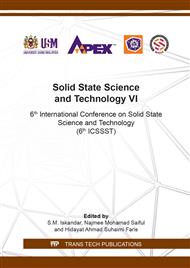p.53
p.60
p.67
p.75
p.81
p.87
p.93
p.101
p.107
Study on the Size Dependence of AuNPs in Enhancement Radiation Effect for Superficial Kilovoltage X-Rays
Abstract:
Radiation therapy and chemotherapy remain the most widely used treatment options in treating cancer. Recent developments in cancer research show that therapy combined with high-atomic number materials such as gold nanoparticles (AuNPs) is a new way to treat cancer, in which AuNPs are injected through intravenous administration and bound to tumor sites has enhanced tumor cell killing. Radiation therapy aims to deliver a high therapeutic dose of ionizing radiation to the tumor without exceeding normal tissue tolerance. In this work AuNPs have been used for the enhancement of radiation effects on breast cancer cells (MCF-7) for superficial kilovoltage X-ray radiation therapy. The use of AuNPs in superficial kilovoltage X-ray beams radiation therapy will provide a high probability for photon interaction by photoelectric effect. These provide advantages in terms of radiation dose enhancement. In this work, MCF-7 cells were seeded in the 96-well plate and treated with 13 nm, 50 nm and 70 nm AuNPs before they were irradiated with 80 kVp X-rays beam at various radiation doses. Photoelectric effect is the dominant process of interaction of 80 kVp X-rays with AuNPs. When the AuNPs are internalized into the MCF-7 cells, the dose enhancement effect is observed. The presence of AuNPs in the MCF-7 cells will produce a higher number of photoelectrons, and resulting more “free radicals” that will lead to increase in cell death. Then, these free radicals will lead to DNA damage to the MCF-7 cells. To validate the enhanced killing effect, both with and without AuNPs MCF-7 cells is irradiated simultaneously. By comparison, the results show that AuNPs significantly enhance cancer killing and the enhancement radiation effect was dependent on the size of AuNPs.
Info:
Periodical:
Pages:
81-86
Citation:
Online since:
April 2019
Keywords:
Price:
Сopyright:
© 2019 Trans Tech Publications Ltd. All Rights Reserved
Share:
Citation:


